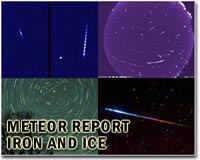 |
Madison WI (SPX) Apr 16, 2010 A rooftop webcam at the University of Wisconsin-Madison captured the final seconds of a fireball's Wednesday, April 14 descent into the atmosphere. A fireball is a meteor, or "shooting star," that emits a brilliant light as it enters Earth's atmosphere. News reports in the area indicated that 911 call centers in at least six states began to light up with calls reporting the celestial visitor a little after 10 p.m. local time. Eyewitness accounts stated it was moving from west to east and broke into multiple pieces. Numerous witnesses also heard crackling sounds and a sonic boom. It is not know yet if any debris from the fireball survived the intense heat of atmospheric entry and made it to Earth's surface. "The frequency of space debris entering our atmosphere that is large enough to generate a fireball is something on the order of once or twice a day," said Don Yeomans of NASA's Near-Earth Object Office at the Jet Propulsion Laboratory in Pasadena, Calif. "What is somewhat unique about this one is that it was witnessed by so many and captured on tape. Sounds like it was spectacular. I wish I had been there to see it, too." Data collected by scientists at NASA's Marshall's Space Flight Center, Huntsville, Ala., indicate the parent body of the fireball was approximately 1 meter (3.3 feet) in length and was not associated with the Gamma Virginids meteor shower, which was taking place at the time the fireball entered the atmosphere. Instead, the small space rock more than likely originated from somewhere in the asteroid belt. When the fireball disintegrated high in the atmosphere, it released energy equivalent to the detonation of approximately 20 tons of TNT. "Knowing the size of this small asteroid helps us determine the frequency of such occurrences," said Yeomans. "Asteroids this size are expected to enter Earth's atmosphere about once a month." NASA detects, tracks and characterizes asteroids and comets passing close to Earth using both ground- and space-based telescopes. The Near-Earth Object Observations Program, commonly called "Spaceguard," discovers these objects, characterizes a subset of them, and plots their orbits to determine if any could be potentially hazardous to our planet. JPL manages the Near-Earth Object Program Office for NASA's Science Mission Directorate in Washington. JPL is a division of the California Institute of Technology in Pasadena. Images of the fireball from the webcam are online here.
Share This Article With Planet Earth
Related Links Asteroids and near-Earth objects at JPL Asteroid and Comet Impact Danger To Earth - News and Science
 Large meteor lights up Midwest night sky
Large meteor lights up Midwest night skyLancaster, Wis. (UPI) Apr 15, 2010 A large meteor streaked over the U.S. Midwest Wednesday, briefly lighting up the night sky and unleashing a sonic boom heard for hundreds of miles. No injuries or damage were reported, but the ground, trees, homes and various objects, including wind chimes, shook from the boom's enormous amounts of sound energy, the National Weather Service said. The meteoroid, estimated at 6 fee ... read more |
|
| The content herein, unless otherwise known to be public domain, are Copyright 1995-2010 - SpaceDaily. AFP and UPI Wire Stories are copyright Agence France-Presse and United Press International. ESA Portal Reports are copyright European Space Agency. All NASA sourced material is public domain. Additional copyrights may apply in whole or part to other bona fide parties. Advertising does not imply endorsement,agreement or approval of any opinions, statements or information provided by SpaceDaily on any Web page published or hosted by SpaceDaily. Privacy Statement |